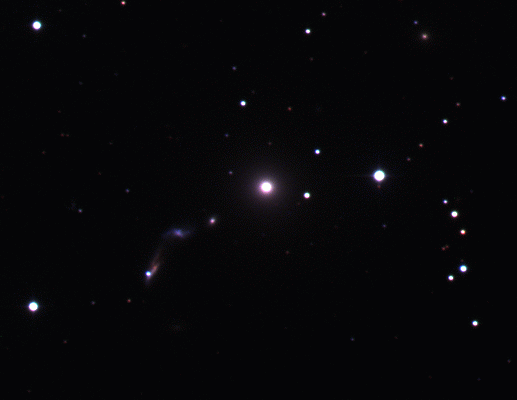 |
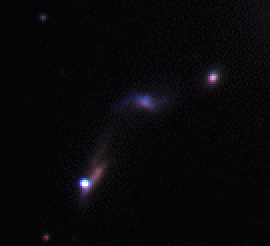
Composite RGB image (created from individual B, V, and R exposures obtained
with CAFOS at the 2.2 m telescope) of the
Hickson Compact Group HCG34, showing the discovery of SN 2004gc (the brightest
object within the reddest galaxy in the above panel) |
 |

Composite RGB image (created from individual B, V, and R exposures obtained
with CAFOS at the 2.2 m telescope) of the
Hickson Compact Group HCG34, showing the discovery of SN 2004gc (the brightest
object within the reddest galaxy in the above panel) |
Introduction
The host galaxy of the SN 2004gc supernova belongs to the Hickson Compact Group HCG34 (Arp327). The SN was observed during an observing run of HCG groups. Compact groups, composed of 4-8 galaxies, have high galaxy densities similar to those observed in cluster cores and low velocity dispersion, and therefore tidal interactions are expected to be continuous and dynamically important. These properties make the HCG groups excellent laboratories to test the importance of interaction for triggering nuclear activity. This is the main goal of our project and we plan to measure the nuclear activity in all galaxies belonging to a selected sample of Compact Groups and to study the relationship between the characteristics of the nuclear activity and the properties and level of interaction of the host galaxies and in the parent group. With this aim, we are obtaining medium resolution spectroscopy in the 3600-7200 Å spectral range for all the nuclei of the galaxies of a well defined statistically complete sample of Compact Groups. HCG 34 belongs to the sample and it is composed of four galaxies, with a dominant elliptical galaxy plus three spirals showing a very compact structure. Particularly, HCG 34B, the galaxy hosting the SN, was classified as a Sd by Hickson et al. (1989). It shows a distorted morphology with a tidal-like feature and it is in evident interaction with another spiral member of the group, HCG34C. The SN is located about 4.5 arcsec to the SE of the galaxy nucleus.
Before the SN explosion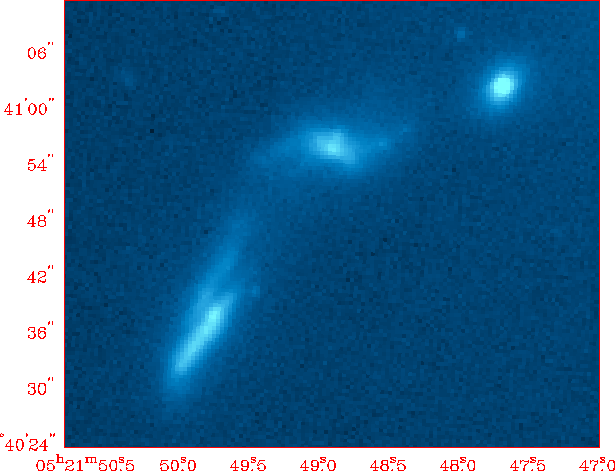
(click to enlarge) |
After the SN explosion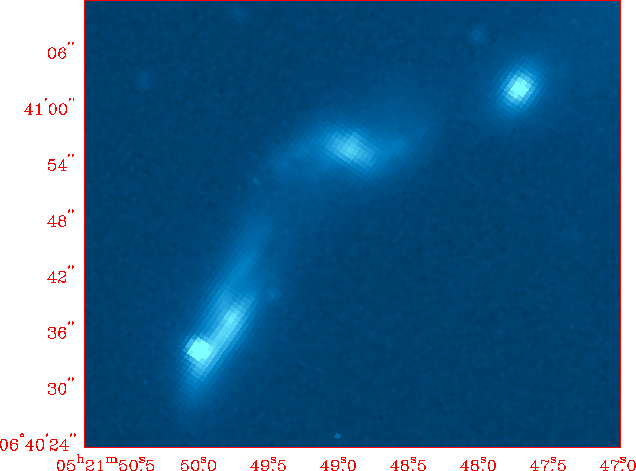
(click to enlarge) |
Observation and Data Reduction
The spectroscopic and photometric observation were made on 18th and 19th November 2004 using the 2.2m telescope of Calar Alto Observatory equipped with the CAFOS spectrograph and the SITe1d CCD (0.53arcsec/pix). The nights were photometric and the seeing was between 1 and 1.2 arcsec. We made three exposures of 600sec of the SN with a slit width of 2arcsec and using the B200 grism that has a spectral resolution of 4.7 Å/pix and cover a range from 3500 to 7500 Å. We got also direct images with the Johnson B,V,R,I filters and a exposure time of 180sec each one. The data were reduced with IRAF package. Wavelength calibration was accomplished with HgCdAr, He and Rb lamps. The apall task was used to extract the spectrum and remove the sky lines. We observed the spectrophotometric standard stars GD71, HD19445, and Pi2 Orionis in order to get a proper flux calibration of the SN spectrum. Reduction of the images were carried out using standard techniques. The atmospheric extinction and the flux calibration to the standard system were determined from observations in the four filters of the standard stars GD71 and the stars in the PG0918+029 Landolt field.
Spectrum identification
In Figure 1. we show the spectrum of the SN 2004gc. It is corrected for the redshift (z=0.03126) of the host galaxy HCG34B, obtained from its H_alpha and [NII] emission lines. The main absorption identified lines are labeled in the figure. The comparison between our spectrum and those of Branch et al. (2003) confirms that the spectrum corresponds to a type Ia supernova observed approximately one week after the maximum. To identify the main ions that contribute to the detected absorption features we have take into account the synthetics spectrum used in the paper mentioned above. The most prominent lines in the SN 2004gc spectrum are the deep SiII absorption near 6100 and the SII W-shape feature from about 5300Å to 5500Å that characterize a supernova type Ia. We also detect FeIII, FeII, MgII and CaII. The elements that contribute mainly to each observed absorption line are presented in the next table. Considering the SiII line, we obtain a blue-shifted velocity of about 10237km/s.

| Absorption Feature | CaII 3945 | SiII 4130 | FeII 4025 | FeII 4549 | FeIII 4420 | MgII 4481 | FeII 5169 | SII 5208 | SiII 5051 | FeIII 5156 | SII 5468 | SII 5654 | FeIII 6000 | SiII 5972 | SiII 6355 |
| Wavelength | 3743.9 | 4015.8 | 4015.8 | 4349.0 | 4349.0 | 4349.0 | 4840.2 | 4840.2 | 4840.2 | 4989.3 | 5322.5 | 5489.2 | 5778.6 | 5778.6 | 6138.1 |
Brightness and Extinction
Next image show the B, V, R and I frames of the HCG34 group with the
SN 2004gc in HCG34B.
Due to the low galactic latitude of the group (b=-16.49), and the
position of the SN inside the galaxy, the interstellar extinction due
to both our Galaxy and the host galaxy is strong. We have corrected
the observed magnitudes and color indices for Galactic absorption using
the results of the extinction of the Milky Way
computed by Schlegel et al. (1998) and it amounts A_B=0.89 and E(B-V)=0.206.
Since we don't know the color excess ought to the fact that the
SN is whitin the host galaxy, we have calculated the magnitudes of the SN by
aperture photometry and subtracting the flux corresponding
to an area near the supernova, containing the contribution of the host
galaxy disk. Next table list the obtained V magnitude and color indices:
| M(V) | (B-V)o | (V-R)o | (V-I)o |
| 16.866 | 0.014 | 0.077 | -0.554 |
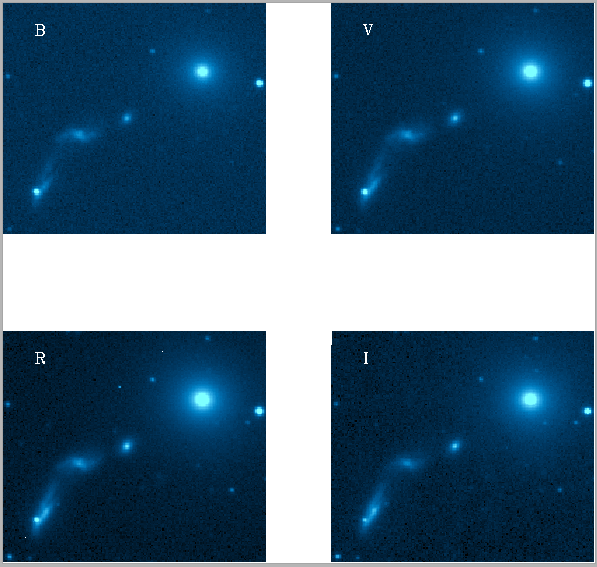
References